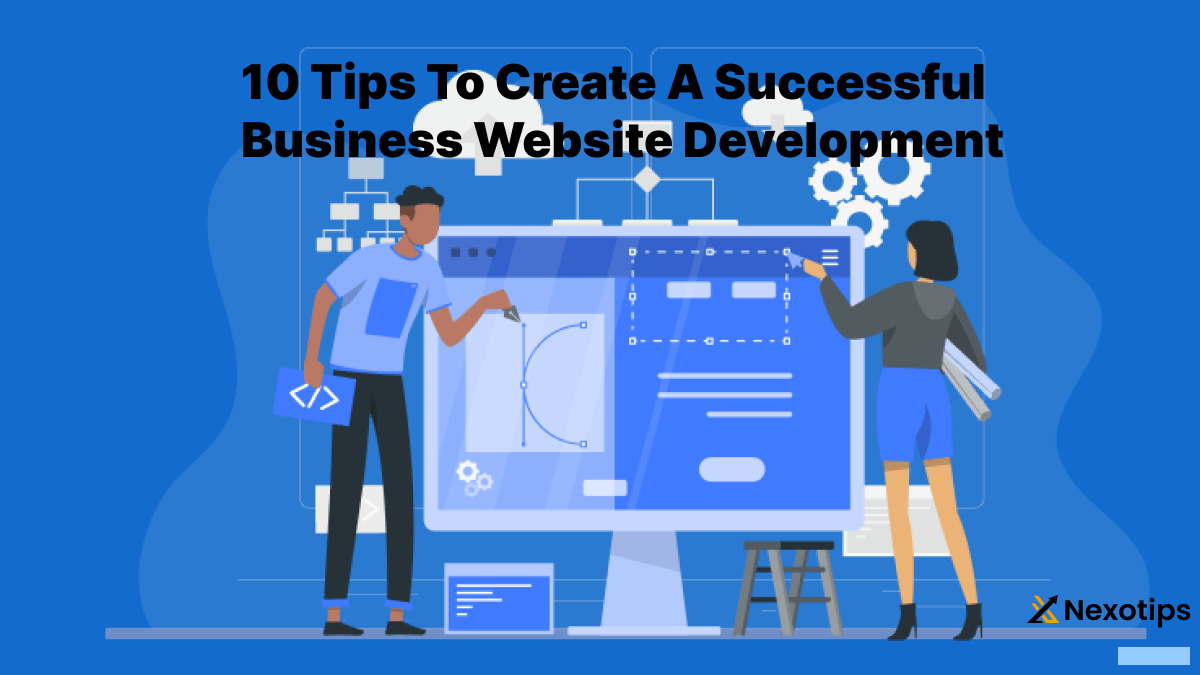
10 Tips To Create A Successful Business Website Development
Successful business website
Creating a successful business website is a critical step for any company aiming to establish an online presence. A well-designed website can help attract potential customers, improve user experience, and ultimately drive sales. Here are ten essential tips to guide you through the process of developing a successful business website.
Index of Contents
1. Define Your Goals and Objectives
It’s critical to establish your goals and objectives before you begin website design. Understanding what you want to achieve with your website will help you make informed decisions throughout the development process. Common goals for a business website include:
- Increasing brand awareness: Showcasing your brand’s story, values, and products or services.
- Generating leads: Capturing visitor information through forms, newsletters, and other lead generation tools.
- Driving sales: Facilitating online purchases or directing customers to physical locations.
- Providing customer support: Offering resources, FAQs, and contact options for customer service.
Having clear goals will help you prioritize features and content, ensuring your website aligns with your business objectives.
2. Understand Your Target Audience
Knowing your target audience is essential for creating a website that meets their needs and preferences. Conduct market research to gather insights into your potential customers’ demographics, behaviors, and preferences. This information will guide your design choices, content creation, and marketing strategies.
When determining who your target audience is, take into account these factors:
- Demographics: Age, gender, location, education, income level.
- Behavior: Online habits, purchasing behavior, preferred devices.
- Needs and Pain Points: Common challenges your audience faces and how your products or services can solve them.
Understanding your audience will help you create a user-friendly website that resonates with your visitors and encourages engagement.

3. Choose the Right Platform
Selecting the right platform is a crucial decision in the website development process. Several website-building platforms are available, each with its strengths and weaknesses. Consider the following popular options:
- WordPress: Ideal for flexibility and customization, with a vast array of plugins and themes.
- Shopify: Excellent for e-commerce websites, offering robust features for online stores.
- Wix: User-friendly with drag-and-drop functionality, suitable for small businesses and beginners.
- Squarespace: Great for visually appealing websites with built-in templates and design tools.
Evaluate each platform based on your specific needs, technical expertise, and budget. The right platform will provide the foundation for a successful business website.
4. Focus on User Experience (UX)
The user experience (UX) is a crucial factor in the success of your website. A positive UX ensures that visitors can easily navigate your site, find the information they need, and complete desired actions. Consider the following tips to enhance UX:
- Mobile Responsiveness: Ensure your website is mobile-friendly and provides a seamless experience across all devices.
- Intuitive Navigation: Design a clear and straightforward menu structure that allows users to find content easily.
- Quick Loading Times: To cut down on page load times, optimize your images and make use of effective coding techniques.
- Clear Calls to Action (CTAs): Use prominent and compelling CTAs to guide users towards desired actions, such as signing up for a newsletter or making a purchase.
Prioritizing UX will help you create a website that visitors enjoy using, increasing the likelihood of conversions and repeat visits.
5. Optimize for Search Engines (SEO)
SEO is a crucial component in bringing in natural search traffic to your website. You may raise your website’s exposure in search results and draw in more visitors by making it more search engine friendly. Here are some key SEO strategies:
- Do some keyword research to find the words and phrases that people who are interested in your product are using. Use tools like Google Keyword Planner, Ahrefs, or SEMrush to find high-volume, low-competition keywords.
- On-Page SEO: Optimize your website’s content, meta tags, headers, and URLs with targeted keywords. Ensure that each page has unique and descriptive titles and meta descriptions.
- Content Quality: Provide your readers with valuable, enlightening, and captivating content. Continually add new information to your news section or blog.
- Technical SEO: Ensure your website has a clean and efficient code, fast loading times, and a secure HTTPS connection. Use tools like Google Search Console to monitor and fix any technical issues.
Implementing effective SEO practices will help your website rank higher in search engine results, driving more organic traffic and potential customers.
6. Create Engaging and Relevant Content
The most important element of every successful website is content. Engaging and relevant content can attract visitors, keep them on your site longer, and encourage them to take action. Consider the following content strategies:
- Blog Posts: Regularly publish blog posts on topics related to your industry, products, or services. Provide valuable information, tips, and insights that address your audience’s needs and interests.
- Product Descriptions: Write detailed and compelling product descriptions that highlight the features, benefits, and unique selling points of your products.
- Visual Content: Use high-quality images, videos, infographics, and other visual content to enhance your website’s appeal and engagement.
- Customer Testimonials: Showcase customer reviews and testimonials to build trust and credibility with your audience.
Creating diverse and high-quality content will help you connect with your audience, establish your expertise, and drive conversions.
7. Implement Strong Security Measures
Security is a top priority for any business website, especially if you handle sensitive customer information or conduct online transactions. Implementing strong security measures will protect your website from cyber threats and build trust with your visitors. Consider the following security practices:
- Obtain an SSL certificate to verify that your website is using HTTPS. This encrypts data transmitted between your website and users, enhancing security and trust.
- Regular Updates: Keep your website’s software, plugins, and themes up to date to protect against vulnerabilities.
- Secure Passwords: Use strong, unique passwords for all accounts associated with your website. Consider implementing two-factor authentication for added security.
- Backup Solutions: Regularly back up your website’s data to prevent loss in case of a security breach or technical issue.
By prioritizing security, you can protect your website and customer data, ensuring a safe and trustworthy online experience.
8. Leverage Social Media Integration
Integrating social media with your website can help you reach a wider audience, drive traffic, and engage with your customers. Here are some ways to leverage social media integration:
- Social Sharing Buttons: Add social sharing buttons to your blog posts, product pages, and other content to encourage visitors to share your content on their social networks.
- Social Media Feeds: Display live social media feeds on your website to showcase your latest posts and updates.
- Login Integration: Allow users to create accounts or log in using their social media profiles for a seamless user experience.
- Cross-Promotion: Promote your website content on your social media channels and vice versa to drive traffic and engagement.
By integrating social media, you can enhance your online presence, foster community engagement, and drive more traffic to your website.

9. Monitor and Analyze Performance
Regularly monitoring and analyzing your website’s performance is essential for continuous improvement and success. Use analytics tools to track key metrics and gain insights into your visitors’ behavior. Here are some important metrics to monitor:
- Traffic Sources: Understand where your visitors are coming from, whether it’s organic search, social media, referral links, or direct traffic.
- Track the percentage of users who abandon your website after only viewing one page, or the “bounce rate.” A high bounce rate may indicate issues with your content or user experience.
- Conversion Rate: Track the percentage of visitors who complete desired actions, such as making a purchase or filling out a form.
- Page Views and Time on Site: Analyze which pages are most popular and how long visitors are spending on your site.
Using tools like Google Analytics, you can gather valuable data to inform your decisions and optimize your website for better performance.
10. Continuously Update and Improve
A successful business website is never truly finished. It’s important to continuously update and improve your site to keep it relevant, user-friendly, and competitive. Here are some ways to ensure your website stays up-to-date:
- Regular Content Updates: Keep your content fresh and relevant by regularly adding new blog posts, product updates, and other valuable information.
- Design Refreshes: Periodically update your website’s design to keep it modern and visually appealing. This can include updating images, fonts, and layouts.
- Functionality Enhancements: Add new features and functionalities to improve user experience and meet changing customer needs.
- Feedback and Testing: Gather feedback from users and conduct regular usability testing to identify areas for improvement.
By committing to continuous improvement, you can ensure your website remains an effective tool for achieving your business goals.
Creating a successful business website requires careful planning, a focus on user experience, and a commitment to ongoing improvement. By following these ten tips, you can develop a website that not only meets your business objectives but also provides value to your visitors. Remember to define your goals, understand your audience, choose the right platform, and prioritize SEO and security. With engaging content, social media integration, and regular performance monitoring, your website can become a powerful asset for your business.
Nexotips: Your Trusted Partner in Successful Business Website Development.
At Nexotips, with over 5 years of expertise in website development, we understand the intricacies of creating a successful business website. Our experienced developer team is dedicated to delivering top-notch solutions that not only meet your business goals but also provide an exceptional user experience. Whether you’re looking to enhance your brand’s online presence or drive sales through a high-performing e-commerce platform, Nexotips is your trusted partner in website development.
Others: Understanding Pointers In C: A Comprehensive Guide.
